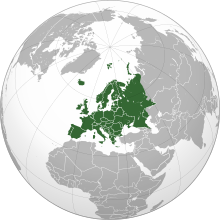 Several of the oldest cities of Northwestern Europe are highlighted in this astronaut's photograph from 00:25 GMT on 10 August 2011  | |
| Area | 10,180,000 km2 (3,930,000 sq mi)[n] (6th) |
|---|---|
| Population | 742,452,000[n] (2013; 3rd) |
| Population density | 72.9/km2 (188/sq mi) (2nd) |
| Demonym | European |
| Countries | 50 sovereign states 5 with limited recognition |
| Dependencies | 4 dependencies |
| Languages | ~225 languages[1] |
| Time zones | UTC−1 to UTC+5 |
Europe is traditionally defined as one of seven continents. Physiographically, it is the northwestern peninsula of the larger landmass known as Eurasia (or the larger Afro-Eurasia); Asia occupies the centre and east of this continuous landmass. Europe's eastern frontier is usually delineated by the Ural Mountains in Russia, which is the largest country by land area in the continent. The southeast boundary with Asia is not universally defined, but the modern definition is generally the Ural River or, less commonly, the Emba River. The boundary continues to the Caspian Sea, the crest of the Caucasus Mountains (or, less commonly, the river Kura in the Caucasus), and on to the Black Sea. The Bosporus, the Sea of Marmara, and the Dardanelles conclude the Asian boundary. The Mediterranean Sea to the south separates Europe from Africa. The western boundary is the Atlantic Ocean. Iceland is usually included in Europe because it is over twice as close to mainland Europe as mainland North America. There is ongoing debate on where the geographical centre of Europe falls.
- ^ Language facts – European day of languages, Council of Europe. Retrieved 30 July 2015.